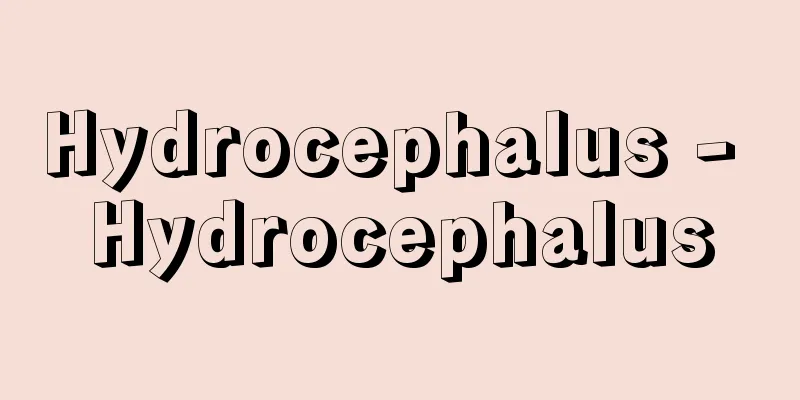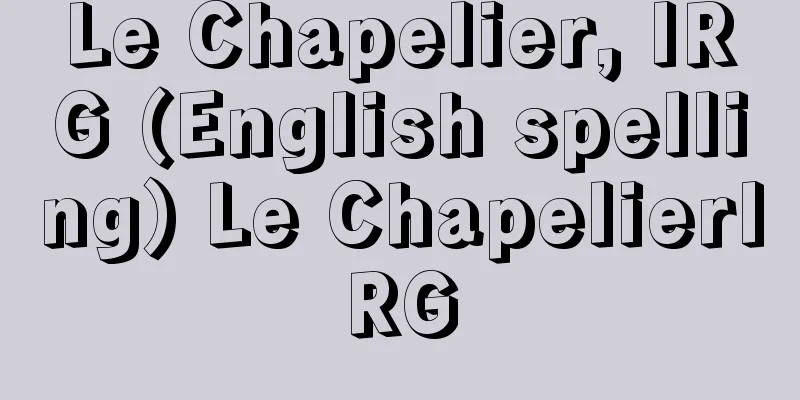Hydrocephalus - Hydrocephalus

|
[What kind of disease is it?] The amount of cerebrospinal fluid produced and absorbed is balanced (Column: "Balance between production and absorption of cerebrospinal fluid"). When the flow and absorption of cerebrospinal fluid is impaired by some disease, the fluid accumulates abnormally in the ventricles or subarachnoid space of the brain. This condition is called hydrocephalus. [Cause] Hydrocephalus can be caused by brain tumors or cancer, meningitis caused by infection with bacteria, viruses or parasites, brain trauma, intracerebral hemorrhage caused by the rupture of a cerebral aneurysm or high blood pressure, intraventricular hemorrhage which is common in premature infants, and morphological abnormalities of the brain (congenital diseases). Brain morphological abnormalities that can cause hydrocephalus include aqueductal stenosis, Chiari II malformation combined with myelomeningocele, communicating hydrocephalus in which the flow of cerebrospinal fluid into the venous sinuses is obstructed, Dandy-Walker syndrome, and encephalocele. [Symptoms] Symptoms vary depending on age. Symptoms in babies (infants): The head becomes abnormally large, and pressure inside the head increases (intracranial pressure). As the increase in intracranial pressure progresses, the veins in the skin of the head become distended and bulge, causing the eyeball to repeatedly drop downward, with the lower half of the pupil hanging over the lower eyelid, and the white of the eye becoming prominent (a phenomenon known as sundown). When the baby is sitting and feeding, the fontanel is not indented and may be swollen and tense. The baby also has a tendency to have stiff limbs. If the increase in intracranial pressure progresses rapidly, symptoms such as vomiting, convulsions, irritability, and lethargy (a drowsy state) may appear. The baby may also burst into repeated, high-pitched cries, possibly due to the headache. If the increase in intracranial pressure occurs slowly, the symptoms described above will not be noticeable, but brain development will be impaired and the child will not grow at an appropriate rate for his or her age. Symptoms in infants and older children Increased intracranial pressure occurs not only in adults but also in children, causing frequent headaches and vomiting. Headaches tend to occur early in the morning, and vomiting occurs suddenly without nausea. It also leads to a decrease in attention and concentration, impairing normal daily life. As the increase in intracranial pressure worsens, the patient will become drowsy (will fall asleep if not stimulated), and eventually will lose consciousness. Furthermore, movement disorders of the limbs, such as walking disorders, and eye movement disorders will also occur. Symptoms of normal pressure hydrocephalus Normal pressure hydrocephalus occurs in elderly people. It causes mental dysfunction such as dementia, walking disorder, and urinary incontinence, but it is not uncommon for these three symptoms to not occur together. In normal pressure hydrocephalus, the underlying condition cannot usually be identified (idiopathic normal pressure hydrocephalus). [Testing and diagnosis] Diagnosis is by CT or MRI of the head. In many cases, these tests can identify the underlying disease, but in cases of hydrocephalus associated with morphological abnormalities of the brain, the cause is often unclear. Hydrocephalus in children with seizures requires evaluation by a paediatric neurologist and an EEG. [Treatment] If a tumor, hemorrhage, or hematoma is blocking the flow of cerebrospinal fluid within the ventricles, it will be removed surgically. If the lesion cannot be removed, a shunt procedure is performed to drain the accumulated cerebrospinal fluid into the abdominal or pleural cavity. In a shunt procedure, a silicon tube (shunt tube) is implanted under the skin to short-circuit (connect) the ventricles and the abdominal or pleural cavity, or the subarachnoid space of the spinal cord and the abdominal or pleural cavity. When meningitis caused by bacterial infection or other factors occurs, cerebrospinal fluid is drained from the body from the ventricles etc., and a shunt procedure is performed once the infection has subsided. In cases where hydrocephalus has occurred due to blockage of the cerebral aqueduct, or where there is a tumor in the fourth ventricle that is impeding the flow of cerebrospinal fluid within the ventricles, a third ventriculostomy is performed using a ventriculoscope to connect the third ventricle to the subarachnoid space at the base of the brain. In this case, there is no need to install a shunt tube. [Precautions in daily life] People treated for hydrocephalus should see a neurosurgeon regularly. If the disease is well controlled, they can enjoy a normal life. Source: Shogakukan Home Medical Library Information |
|
[どんな病気か] 髄液(ずいえき)の生産量と吸収量とは、バランスがとれています(コラム「髄液の産生と吸収のバランス」)。 髄液の流れと吸収が、なんらかの病気で障害されると、髄液が脳室(のうしつ)や脳のくも膜下腔(まくかくう)に異常に貯留します。この状態を水頭症といいます。 [原因] 脳の腫瘍(しゅよう)やがん、細菌・ウイルス・寄生虫などの感染でおこる髄膜炎(ずいまくえん)、脳の外傷、脳動脈瘤(のうどうみゃくりゅう)の破裂や高血圧が原因でおこる脳内出血(のうないしゅっけつ)、未熟児におこりやすい脳室内出血、脳の形態異常(先天性の病気)などで水頭症がおこってきます。 水頭症の原因となる脳の形態異常には、中脳水道狭窄症(ちゅうのうすいどうきょうさくしょう)、脊髄髄膜瘤(せきずいずいまくりゅう)に合併したキアリーⅡ型奇形(がたきけい)、髄液の静脈洞(じょうみゃくどう)への流入が障害される交通性水頭症(こうつうせいすいとうしょう)、ダンディー・ウォーカー症候群(しょうこうぐん)、脳瘤(のうりゅう)などがあります。 [症状] 年齢によって、症状が異なります。 ●赤ちゃん(乳児)の症状 頭が異常に大きくなり、頭の中の圧力が上がってきます(頭蓋内圧亢進(ずがいないあつこうしん))。頭蓋内圧の亢進が進むと、頭の皮膚の静脈が怒張(どちょう)してふくらみ、くり返し眼球(がんきゅう)が下転して、黒目(くろめ)の下半分が下まぶたにかかり、白目(しろめ)が目立つ落日現象(らくじつげんしょう)がおこります。 赤ちゃんを座らせてミルクを飲ませたときに大泉門(だいせんもん)を触れると、そのへこみがなく、ときには盛り上がって緊満(きんまん)している場合もあります。また、四肢(しし)(両手足)を突っ張る傾向もあります。 頭蓋内圧亢進が急速に進むと、嘔吐(おうと)やけいれん、さらには不機嫌、嗜眠傾向(しみんけいこう)(うとうと眠る状態)が現われ、頭痛のためか、赤ちゃんが甲高(かんだか)い声でくり返し発作的(ほっさてき)に泣くこともあります。 頭蓋内圧の亢進がゆっくりとおこった場合は、前述のような症状はあまり目立ちませんが、脳の発達が障害されるために、月齢、年齢にふさわしい発育がみられません。 ●幼児以上の子どもの症状 成人だけでなく、子どもの場合も頭蓋内圧亢進がおこり、そのため頭痛、嘔吐が頻繁(ひんぱん)におこるようになります。 頭痛は明け方におこりやすく、嘔吐は吐(は)き気(け)をともなわないで急におこります。また、注意力、集中力の低下を招き、健常な日常生活が損なわれます。 頭蓋内圧亢進がしだいに悪化すると傾眠(けいみん)傾向(刺激を与えないと眠ってしまう)となり、ついには、意識障害がおこります。さらに、歩行障害など手足の運動障害、眼球運動障害もおこってきます。 ●正常圧水頭症(せいじょうあつすいとうしょう)の症状 正常圧水頭症は高齢者におこります。認知症(にんちしょう)などの精神機能障害、歩行障害、尿失禁(にょうしっきん)がおこりますが、これら3つの症状がそろわないケースもまれではありません。 正常圧水頭症は、原因となった病気を明らかにすることはできないのがふつうです(特発性正常圧水頭症(とくはつせいせいじょうあつすいとうしょう))。 [検査と診断] 頭部のCTやMRIで診断します。これらの検査で多くの場合、原因となった病気がわかりますが、脳の形態異常に合併した水頭症では、原因を明らかにできないことも少なくありません。 けいれんを合併する子どもの水頭症は、小児神経学の専門家の診察と脳波検査が必要です。 [治療] 腫瘍(しゅよう)や出血、血腫(けっしゅ)などが脳室内の髄液の流れを障害していれば、外科的治療で除去します。 病巣(びょうそう)を除去できない場合は、貯留する髄液を腹腔(ふくくう)や胸膜腔(きょうまくくう)に導出する短絡術(たんらくじゅつ)(シャント術)を行ないます。シャント術ではシリコンのチューブ(短絡管)を皮下に埋め込み、脳室と腹腔や胸膜腔、脊髄のくも膜下腔と腹腔や胸膜腔とを短絡(つなぐこと)します。 細菌感染などによる髄膜炎(ずいまくえん)がおこっているときは、脳室などから髄液を体外に流し出し、感染が治った時点でシャント術を行ないます。 中脳水道が閉塞(へいそく)して水頭症となっている場合や、第四脳室に腫瘍があって脳室内の髄液の流れが障害されている場合には、脳室鏡(のうしつきょう)を用いて第三脳室と脳底のくも膜下腔に交通をつける第三脳室開窓術が行なわれます。この場合は、短絡管の設置は必要ありません。 [日常生活の注意] 水頭症の治療を受けた人は、定期的な脳神経外科医の診察を受けることが必要です。病気の管理が良好であれば、通常の生活を楽しむことが可能です。 出典 小学館家庭医学館について 情報 |
>>: Pancreatic islets transplantation
Recommend
Ruse - Ruse (English spelling)
The capital of Ruse County in northern Bulgaria. ...
Momentum thrust - momentum thrust
…The output of a propulsion engine is expressed i...
Orion (English spelling)
In Greek mythology, he was a handsome giant hunter...
Yoshiyagasa
A straw hat. It was first worn by Yoshiya Uemura a...
al-Qadhafi (English spelling)
…Official name = Socialist People's Arab Repu...
PASOK
… [Politics and Diplomacy] Since the establishmen...
Dickson, JT
…the American name for polyethylene terephthalate...
Unwin, R.
… His proposal was seen by many as a utopian drea...
Truck farming
This type of agriculture is located far from marke...
Tanuki - Raccoon dog
1. A mammal of the canine family. Head and body le...
General welfare - Ippan no fukushi
...Since ancient Greece, it has been one of the f...
North Pacific High Pressure
A type of high pressure system that develops in t...
International Institute for Strategic Studies
IISS is a private research institute established ...
Furofuki (Furofu) - Furofuki
A typical way to cook daikon. It is sliced into ...
Udaya (English spelling)
…It is located near Patna, the capital of Bihar, ...









